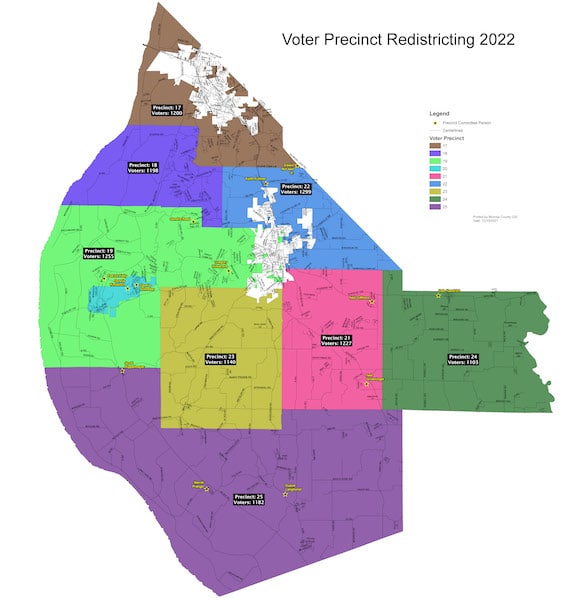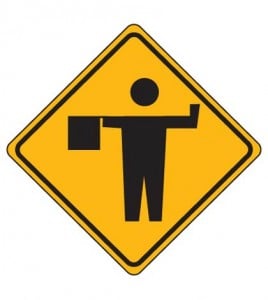New voter precincts approved

In the course of two weeks, Monroe County Clerk Jonathan McLean managed to consolidate 37 city and county voter precincts into 25 with only one minor adjustment requested from a precinct committee chairman.
McLean, with help from Monroe County Director of Mapping and Platting Laura Henry, had the maps available for public review within five days of the Dec. 6 meeting of the Monroe County Board and was able to present the maps for review and approval at Monday’s board meeting.
To see the new maps, click here.
The change was necessitated by Nov. 15 passage of state law that gave counties in Illinois until the end of the year to create voter precincts that include “insofar as is practical” 1,200 voters per precinct.
Some of the city precincts have fewer than 1,000 voters to account for projected growth – most notably Precinct 4 in Columbia, which has fewer than 800 voters, and Waterloo precincts 14 and 12, each with fewer than 900 voters currently.
McLean said the city precincts are subject to change when Waterloo and Columbia adjust their wards in the spring based on population, adding that this ward adjustment must be approved by the respective municipality.
He added the precincts and wards need to be aligned to keep ballots uniform and avoid voter confusion.
McLean noted there is “time to clean up the city wards” and precincts, as no city elections take place until 2023.
The major changes occurred in the rural districts, with many being consolidated.
“The only rural precinct that did not have any changes was Precinct 20 (Valmeyer),” McLean explained. “The Hecker precinct and northern unincorporated Columbia precinct (the new Precinct 17) saw very minor changes. All of the other precincts had significant changes to their boundaries.”
As stated at the Dec. 6 meeting, the multiple options now available to voters (early voting, vote-by-mail) should not keep rural residents from casting a ballot if there’s now a longer drive to their polling location.
In redrawing the maps, there were two instances for each party in which precinct committee members became part of the same precinct.
Two Republican committee members now reside in county precincts 25 and 21. Two Democrat committee members are now in Precinct 19 and three Democrat precinct committee members are in Waterloo’s Precinct 11.
McLean was pleased with the response to what was a significant shift in county voting maps.
“I was expecting a lot more criticism of (the new) map,” McLean said. “But, I am happy to say that the new precinct map received bi-partisan support from the Republicans and Democrats and unanimous approval from our county board of commissioners. I say it was a success.”
The one request for modification was from Democrat precinct committee chairman Scot Luchtefeld. He requested the center line of Osterhage Drive in Waterloo remain the boundary between precincts 11 and 12 rather than change the line to also include houses on the east side of the road in Precinct 11.
Commissioner Vicki Koerber said she would like to see a “simplified” precinct as opposed to splitting streets, but voted to approve the map with the requested change.
McLean and his office is now tasked with re-coding all voters who are now in a new voting precinct.
“It will take (the Monroe County Clerk’s) office several weeks to make all of the changes in our voter registration software,” McLean said. “New voter ID cards will be mailed out sometime this spring” without need for re-registration.
Commissioners thanked McLean and Henry for their quick turnaround in preparing these new precinct maps.
In other county business, Monroe County Engineer Aaron Metzger gave commissioners a semi-annual report.
After the report, Metzger proposed a resolution that would potentially mitigate traffic hazards on Route 3 between Waterloo and Columbia.
The Illinois Department of Commerce and Economic Development is soliciting for projects as part of its Rebuild Downtown and Main Streets Capital Grant Program. The project for which Metzger will seek funding would restrict the intersections at Hanover and Coxeyville roads and EE Road and Granny Lane, restricting left turns onto Route 3 north or south from any of those roads.
The project, which would not commence until the end of 2023 or beginning of 2024, would create restricted crossing U-turn lanes – also known as “R-cuts” or “J-turns” – at the roads’ intersections with Route 3.
The two proposed “R-cuts” would make direct traffic from Granny Lane and EE, Hanover and Coxeyville roads to turn right only onto Route 3 and change direction, if necessary, at a legal U-turn approximately 1,000 feet from the intersections.
The relatively new designs have been implemented successfully in several states as a way to alleviate serious accidents by avoiding left turns onto roads with heavy traffic volume.
Commissioners signed the resolution and Metzger will await approval response.
Oak Hill Administrator Kim Keckritz gave commissioners a review of next year’s budget for the county-owned senior care facility.
She said the budget was “not conservative” and was based on census numbers returning to
pre-COVID levels.
Keckritz based her optimism on a large number of recent referrals to Oak Hill and Evergreen Pointe use so large that the facility is using unoccupied rooms to keep pace with occupancy.
Keckritz also reported census for the current year being under budget, but $114,000 of COVID-related funds kept operating expenses for Oak Hill from being negative.
The employment issue Oak Hill has experienced is getting better, with four new employees being hired as a result of the recent part-time job fair at Waterloo High School.
Keckritz noted she would like to keep the requirement that new nursing staff hires be vaccinated for COVID prior to beginning employment.
In other Oak Hill news, the facility has returned to being a five-star facility as rated by Centers for Medicare and Medicaid Services. The facility had been rated as a four-star facility for the past few years before recently returning to the top CMS rating.
During public comment at the beginning of the meeting, frequent county board attendee Pat Kelly asked commissioners about the recent change of chairmanship from Koerber to Dennis Knobloch.
Knobloch responded there was no “shady” reasons for the change – it was simply a matter of commissioners sharing responsibility.
He also noted that throughout different times in Monroe County’s history, county board chairmanship would be shared rather than having one commissioner as chairman for many years and the current board is opting to follow that precedent.






